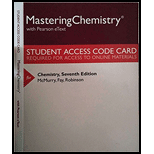
Concept explainers
The half-reactions that occur in ordinary alkaline batteries can be written as
Cathode:
Anode:
In 1999, researchers in Israel reported a new type of alkaline battery, called a "super-iron" battery. This battery uses the same anode reaction as an ordinary alkaline battery but involves the reduction of FeO42− — ion (from K2FeO4) to solid Fe(OH)3 at the cathode.
(a) Use the following standard reduction potential and any data from Appendixes C and D to calculate the standard cell potential expected for an ordinary alkaline battery:
(b) Write a balanced equation for the cathode half-reaction in a super-iron battery. The half-reaction occurs in a basic environment.
(c) A super-iron battery should last longer than an ordinary alkaline battery of the same size and weight because its cathode can provide more charge per unit mass. Quantitatively compare the number Of coulombs Of charge released by the reduction Of 10.0 g Of K2FeO4 to Fe(OH)3with the number of coulombs of charge released by the reduction of 10.0 g of MnO2 to MnO(OH).
Want to see the full answer?
Check out a sample textbook solution
Chapter 18 Solutions
Chemistry - Modified MasteringChemistry
- Another type of battery is the alkaline zinc-mercury cell, in which the cell reaction is Zn(s) + HgO(s) Hg() + ZnO(s) E = + 1.35 V (a) What is the standard free energy change for this reaction? (b) The standard free energy change in a voltaic cell is the maximum electrical energy that the cell can produce. If the reaction in a zinc-mercury cell consumes 1.00 g mercury oxide, what is the standard free energy change? (c) For how many hours could a mercury cell produce a 10-mA current if the limiting reactant is 3.50 g mercury oxide?arrow_forwardA voltaic cell is constructed in which one half-cell consists of a silver wire in an aqueous solution of AgNO3.The other half cell consists of an inert platinum wire in an aqueous solution containing Fe2+(aq) and Fe3+(aq). (a) Calculate the cell potential, assuming standard conditions. (b) Write the net ionic equation for the reaction occurring in the cell. (c) Which electrode is the anode and which is the cathode? (d) If [Ag+] is 0.10 M, and [Fe2+] and [Fe3+] are both 1.0 M, what is the cell potential? Is the net cell reaction still that used in part (a)? If not, what is the net reaction under the new conditions?arrow_forwardDraw a diagram of each cell. Label the anode, the cathode, the species in each half-cell solution, the direction of electron movement in an external circuit, and thedirection of movement of ions within the cell. (a) Cu(s) | Cu2+(aq) || Fe2+(aq) |Fe(s) (b) Pt(s) | H2O2(aq), H+(aq) || Fe2+(aq), Fe3+(aq) | Pt(s)arrow_forward
- In principle, a battery could be made from aluminum metal and chlorine gas. (a) Write a balanced equation for the reaction thatwould occur in a battery using Al3+(aq) | Al(s) andCl2(g) | Cl(aq) half-cells. (b) Identify the half-reaction at the anode and at the cathode. Do electrons flow from the Al electrode when thecell does work? Explain. (c) Calculate the standard potential, Ecell, for the battery.arrow_forwardFour voltaic cells are set up. In each, one half-cell contains a standard hydrogen electrode. The second half-cell is one of the following: (i) Cr3+(aq, 1.0 M)|Cr(s) (ii) Fea+(aq, 1.0M)|Fe(s) (iii) Cu2+(aq, 1.0M)|Cu(s) (iv) Mg2+(aq, 1.0M)|Mg(s) (a) In which of the voltaic cells does the hydrogen electrode serve as the cathode? (b) Which voltaic cell produces the highest potential? Which produces the lowest potential?arrow_forwardYou have 1.0 M solutions of Al(NO3)3 and AgNO3 along with Al and Ag electrodes to construct a voltaic cell. The salt bridge contains a saturated solution of KCl. Complete the picture associated with this problem by a writing the symbols of the elements and ions in the appropriate areas (both solutions and electrodes). b identifying the anode and cathode. c indicating the direction of electron flow through the external circuit. d indicating the cell potential (assume standard conditions, with no current flowing). e writing the appropriate half-reaction under each of the containers. f indicating the direction of ion flow in the salt bridge. g identifying the species undergoing oxidation and reduction. h writing the balanced overall reaction for the cell.arrow_forward
- You want to set up a series of voltaic cells with specific cell potentials. A Zn2+(aq, 1.0 M)| Zn(s) half-cell is in one compartment. Identify several half-cells that you could use so that the cell potential will be close to (a) 1.1 V and (b) 0.50 V. Consider cells in which the zinc cell can be either the cathode or the anode.arrow_forwardThe half cells Sn2+(aq) |Sn(s) and Cl2(g) |Cl(aq) are linked to create a voltaic cell. (a) Write equations for the oxidation and reduction half-reactions and for the overall (cell) reaction. (b) Which half-reaction occurs in the anode compartment, and which occurs in the cathode compartment? (c) Complete the following sentences: Electrons in the external circuit flow from the ______ electrode to the ____ electrode. Negative ions move in the salt bridge from the _____ half-cell to the _____ half-cell.arrow_forward
 Chemistry: Principles and PracticeChemistryISBN:9780534420123Author:Daniel L. Reger, Scott R. Goode, David W. Ball, Edward MercerPublisher:Cengage Learning
Chemistry: Principles and PracticeChemistryISBN:9780534420123Author:Daniel L. Reger, Scott R. Goode, David W. Ball, Edward MercerPublisher:Cengage Learning Chemistry & Chemical ReactivityChemistryISBN:9781133949640Author:John C. Kotz, Paul M. Treichel, John Townsend, David TreichelPublisher:Cengage Learning
Chemistry & Chemical ReactivityChemistryISBN:9781133949640Author:John C. Kotz, Paul M. Treichel, John Townsend, David TreichelPublisher:Cengage Learning Chemistry & Chemical ReactivityChemistryISBN:9781337399074Author:John C. Kotz, Paul M. Treichel, John Townsend, David TreichelPublisher:Cengage Learning
Chemistry & Chemical ReactivityChemistryISBN:9781337399074Author:John C. Kotz, Paul M. Treichel, John Townsend, David TreichelPublisher:Cengage Learning ChemistryChemistryISBN:9781305957404Author:Steven S. Zumdahl, Susan A. Zumdahl, Donald J. DeCostePublisher:Cengage Learning
ChemistryChemistryISBN:9781305957404Author:Steven S. Zumdahl, Susan A. Zumdahl, Donald J. DeCostePublisher:Cengage Learning Chemistry: The Molecular ScienceChemistryISBN:9781285199047Author:John W. Moore, Conrad L. StanitskiPublisher:Cengage Learning
Chemistry: The Molecular ScienceChemistryISBN:9781285199047Author:John W. Moore, Conrad L. StanitskiPublisher:Cengage Learning





